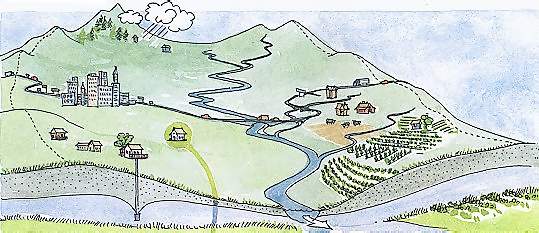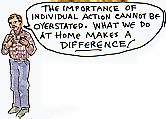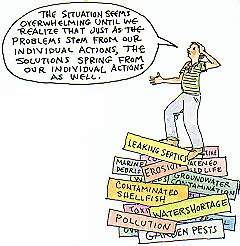For 10,000 years, the waters flowing into the estuary of Puget
Sound have absorbed the materials needed to support this incredible
variety of plants and animals. Today, those same waters carry
more. Every time we wash our hands, clean our drains, or water
our lawns, we can add wastes to the water flowing into Puget Sound.
Excessive sediments from construction sites can threaten the aquatic
life that depends on clean water to survive. Toxic products from
our households threaten fish, shellfish, and pollute the water
which we swim and boat in. Fertilizers from our lawns and gardens
can increase aquatic plant growth in shallow bays and inlets,
using up oxygen needed to support life.


 Small
amounts of pollution from many different sources adding up to
a big problem. Multiply the impacts of a single household’s waste
by a million households and we have a significant source of pollution.
Small
amounts of pollution from many different sources adding up to
a big problem. Multiply the impacts of a single household’s waste
by a million households and we have a significant source of pollution.
 A
few years ago, it was common to point to business and industry
as sources of problems. Regulation, information and treatment
are reducing the impacts from these sources. Yet the quality of
our waters continues to be a concern. Many of our current water
quality problems come from rapid population growth in the Puget
Sound area. Increasing numbers of people increase the pressures
on our waters. Each of our “little” environmental transgressions
seems unimportant by itself. But when added to those of our growing
number of neighbors, we create serious problems.
A
few years ago, it was common to point to business and industry
as sources of problems. Regulation, information and treatment
are reducing the impacts from these sources. Yet the quality of
our waters continues to be a concern. Many of our current water
quality problems come from rapid population growth in the Puget
Sound area. Increasing numbers of people increase the pressures
on our waters. Each of our “little” environmental transgressions
seems unimportant by itself. But when added to those of our growing
number of neighbors, we create serious problems.

 This
publication is dedicated to the enthusiasm and creativity of each
of us living within the watershed of Puget Sound. Though each
of the chapters in the SoundBook may be used separately, the publication’s
lasting value lies in their combined use. Many of the solutions
are simple, many save money, some initially require more work
or thought – they all contribute to protecting the health or our
waters.
This
publication is dedicated to the enthusiasm and creativity of each
of us living within the watershed of Puget Sound. Though each
of the chapters in the SoundBook may be used separately, the publication’s
lasting value lies in their combined use. Many of the solutions
are simple, many save money, some initially require more work
or thought – they all contribute to protecting the health or our
waters.




